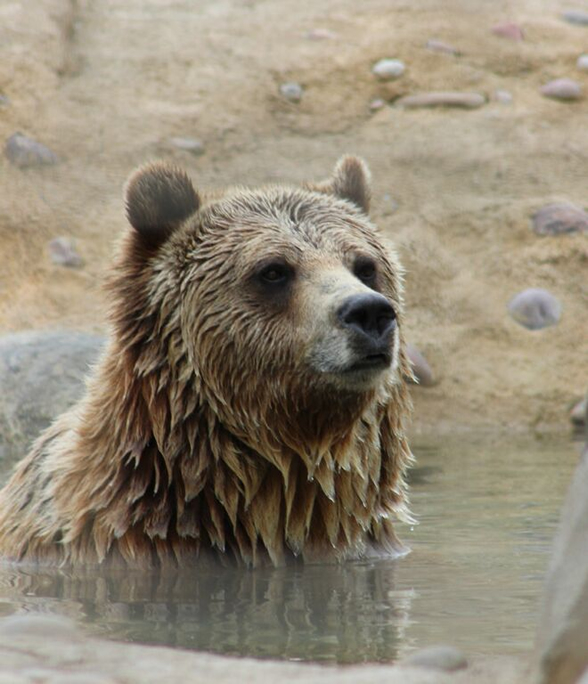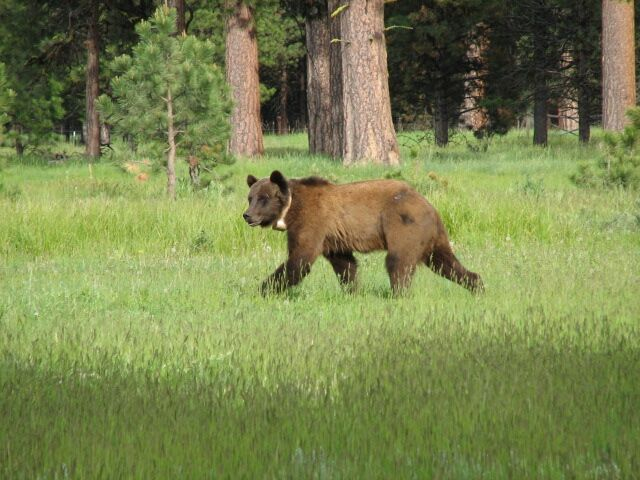

Rainy the Grizzly Bear: A Story of Resilience, Education, and Wildlife Conservation.
In the summer of 2009, Montana Fish, Wildlife and Parks had an unexpected encounter with a female grizzly bear that would capture the hearts and minds of the local community. This grizzly bear, who would later be named Rainy, was spotted roaming around Seeley Lake, MT with a male grizzly bear nicknamed “Scarhip”. The community buzzed with excitement as they watched this pair of bears gallivanting around, crossing highways, and even exploring sheds and pulling down bird feeders. Scarhip, known as a “bad boy” due to his mischievous antics, was eventually trapped and fitted with a collar in June 2009.
But it was Rainy’s story that would truly captivate everyone’s attention. She stayed out of trouble and did what wild bears do, eventually digging a high-elevation den in the Bob Marshall in the late fall of 2009. To everyone’s delight, biologists flew in a helicopter in the spring of 2010 and found Rainy with two cubs! However, things took an unexpected turn in July 2010 when Rainy’s behavior suddenly changed. She was spotted on the porches of multiple homes, pulling down bird feeders, eating grain, and knocking over garbage cans. It was suspected that food stress or opportunistic discoveries of anthropogenic foods may have triggered this behavior.
 Montana Fish, Wildlife and Parks decided to capture Rainy and her cubs to prevent any potential danger. But capturing Rainy proved to be challenging as her behavior escalated, and at one point, she attempted to get into a residence while the family was home. In the midst of this ordeal, tragedy struck as one of Rainy’s cubs was hit and killed by a car while crossing busy Highway 83. Rainy stayed in the area for a few days, seemingly searching for her lost cub, before finally being trapped along with her remaining cub.
Montana Fish, Wildlife and Parks decided to capture Rainy and her cubs to prevent any potential danger. But capturing Rainy proved to be challenging as her behavior escalated, and at one point, she attempted to get into a residence while the family was home. In the midst of this ordeal, tragedy struck as one of Rainy’s cubs was hit and killed by a car while crossing busy Highway 83. Rainy stayed in the area for a few days, seemingly searching for her lost cub, before finally being trapped along with her remaining cub.
Given Rainy’s behavior and the risks associated with her and her cubs navigating developed areas, the decision was made not to relocate her back into the wild. Instead, Rainy and her cub, now named “Monte”, were transported to Tulsa Zoo, which happened to be remodeling its grizzly exhibit. The community of Seeley Lake was deeply affected by Rainy’s story, and residents took action by effectively storing their garbage in bear-resistant manners, removing bird feeders, and discussing ways to prevent conflicts like this in the future.
Rainy and Monte settled into their new habitat at Tulsa Zoo’s Robert J. LaFortune WildLIFE Trek complex in the summer of 2010. Rainy, who enjoys interacting with guests by slapping the glass window of her enclosure, has become a favorite among the zoo’s staff and visitors alike. She has a pool to swim in and enrichment activities to keep her entertained, although she’s a picky eater and sometimes playfully scoots away food she doesn’t want to eat.
Despite the challenges and tragic events in Rainy’s story, her journey has shifted the focus of the community from simply removing bears to actively preventing conflicts and finding ways to coexist with wildlife. Her story continues to raise awareness about the importance of bear-human conflict prevention and the need to protect grizzly bears and their natural habitats.
THANKS, RAINY!
Rainy’s contribution to research projects aimed at preventing human-bear conflict in the wild has been invaluable. Her time at the zoo has allowed her to participate in research conducted in partnership with Oklahoma State University, where she tested feeding devices to assess their durability against her strength. This information was crucial in identifying necessary modifications to the devices to make them more bear-proof.
In addition to testing the physical durability of the feeding devices, Rainy’s behavior was also documented to determine how quickly she could access food in different configurations. Her observations helped researchers gain insights into bear behavior and develop strategies to prevent bears from accessing anthropogenic food sources in the wild.
Rainy’s story has also inspired education and outreach efforts to raise awareness about living safely in bear country. Her presence at the Tulsa Zoo has allowed thousands of visitors to learn about grizzly bears, their ecology, and the importance of coexisting with wildlife. Through educational programs, exhibits, and interpretive signage, Rainy has become an ambassador for her species and a symbol of the challenges and importance of wildlife conservation.
In summary, Rainy’s story is one of adventure, challenges, and resilience. While her journey took an unexpected turn with her relocation to the Tulsa Zoo, it has also served as a catalyst for raising awareness about bear-human conflicts, promoting coexistence, and contributing to research efforts aimed at preventing conflicts in the wild. Her presence at the zoo continues to inspire and educate visitors, and her legacy serves as a reminder of the importance of protecting grizzly bears and their natural habitats.



